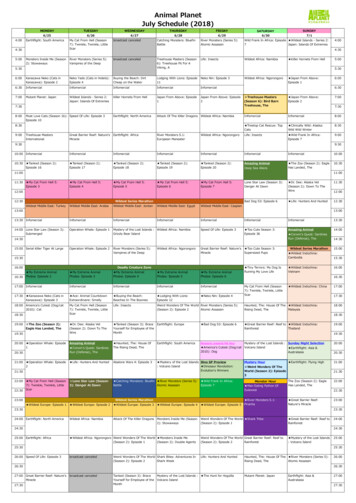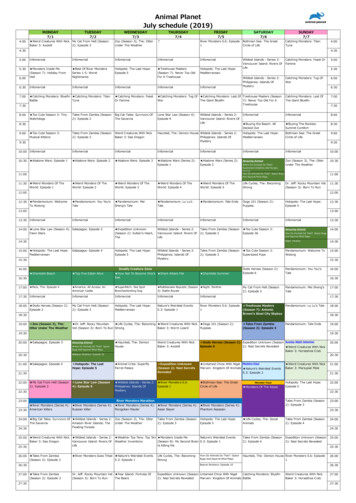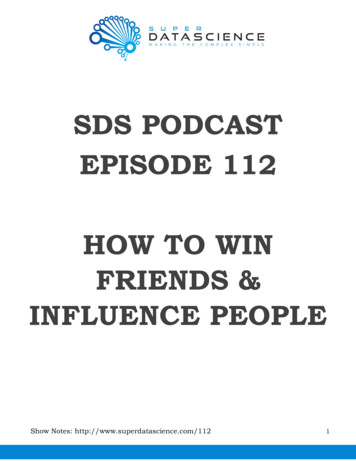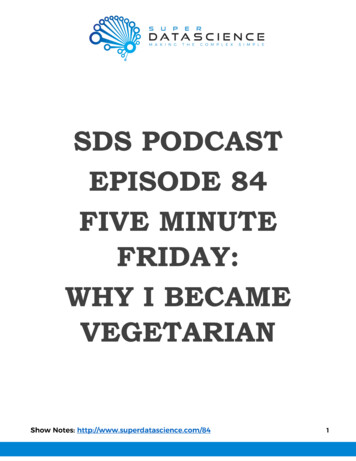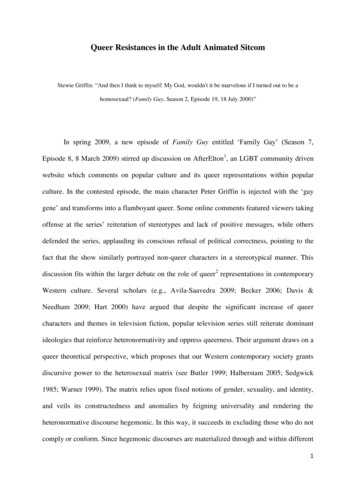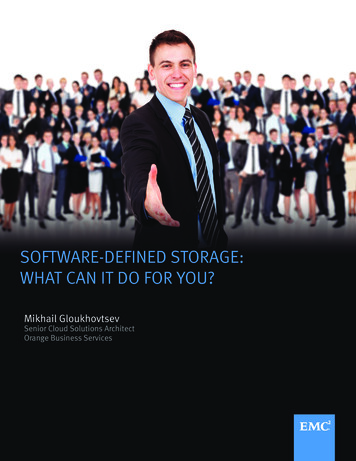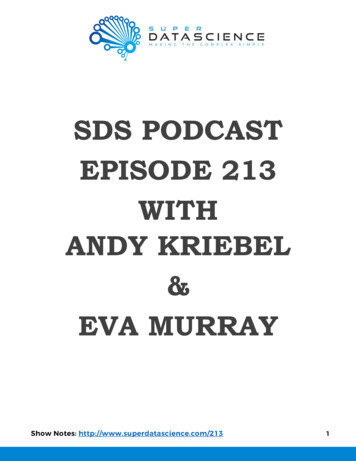
Transcription
SDS PODCASTEPISODE 213WITHANDY KRIEBEL&EVA MURRAY
Kirill Eremenko:This is episode number 213 with the legends of datavisualization, Andy Kriebel and Eva Murray. Welcometo the SuperDataScience Podcast. My name is KirillEremenko, data science coach and lifestyleentrepreneur and each week we bring inspiring peopleand ideas to help you build your successful career indata science. Thanks for being here today and nowlet's make the complex simple.Kirill Eremenko:Welcome back to the SuperDataScience Podcast ladiesand gentlemen, super excited to have you back here onthe show. Today, we've got two very, very specialguests, Andy Kriebel and Eva Murray. Andy and Evahave both been on the podcast before and you can findtheir personal stories and journeys in episodesnumber 91 and 127 respectively and what wediscussed in today's episode is their brand newcreation, the Makeover Monday book.Kirill Eremenko:So some of you may know, especially if you listen tothe podcast or if you follow either Andy or Eva, thatthey host the Makeover Monday Project, which youcan find at makeovermonday.co.uk, where they takevisualizations, one visualization per week, they supplythe datasets to everybody who's interested and thenthey redo that visualization to make it look fantasticand look much, much better. So just randomvisualizations that they find on the internet. Then theyalso critique other people's works, provide advice, theywill have these discussions, there's a wholecommunity around Makeover Monday and now they'resuper excited to announce the launch of their brand
new book, Makeover Monday, which you can pick upon Amazon.Kirill Eremenko:So this episode is all about visualization and why it'simportant for data scientists and machine learningexperts to know how to visualize data and also you willfind some tips that Andy and Eva will be sharing withyou from their brand new book. Very, very excitedabout this episode, can't wait for you to check outamazing tips. By the way, this podcast is available invideo version if you would like to see Andy, Eva andme chatting, you can find it atwww.superdatascience.com/213, or on theSuperDataScience YouTube channel. But if you'relistening to this on the go, then no worries, you'll getall the value from this audio version of the podcast aswell and so on that note, without further ado, I can'twait to bring to you Eva Murray and Andy Kriebel fromMakeover Monday.Kirill Eremenko:Welcome back to the SuperDataScience podcast ladiesand gentlemen, to this super special episode where Ihave not one, but two guests, Andy Kriebel and EvaMurray calling in from different parts of Europe intothis show. How are you guys going today?Eva Murray:Good.Andy Kriebel:Great, how are you?Kirill Eremenko:Awesome. So Andy, you're in the UK, what is it, 6:30for you right now?Andy Kriebel:6:39, yes, it's early.Kirill Eremenko:6:39.
Andy Kriebel:And dark.Kirill Eremenko:Yeah, it's pretty dark and I mentioned that you looklike you're about to get on your bike again, as you doeverywhere.Andy Kriebel:I am, yeah, yeah.Kirill Eremenko:All right, gotcha. And Eva, where are you calling from?Eva Murray:I'm calling from Nuremberg, it's daylight but cold soI'm glad that we're doing this before I have to go out.So it has the chance to warm up a bit more.Kirill Eremenko:Nice and please, dear listeners forgive our guestsbecause they haven't spoken much, as Eva correctlypointed out, since the morning, so might need a bit oftime to warm up. Anyway guys, very excited to haveyou on the podcast. I've had each one of youseparately on the podcast but now, it's like doubletrouble, both of you at the same time. You are amazingguests and first of all, I wanted to congratulate you onyour book that just came out, the Makeover Mondaybook. Congratulations, how are you guys feeling aboutit?Andy Kriebel:It's been overwhelming I would say. Thank you foryour congratulations first of all and thank you for yourkind words on the back of the book. It's been quiteoverwhelming, I was mentioning to you earlier, theweirdest thing for me was actually seeing a physicalcopy of the book but then we get to the Tableauconference and that was, I guess, kind of the officialbook launch, would you say Eva? Something like that?Eva Murray:Yeah, yeah.
Andy Kriebel:And to see people that actually wanted to buy it andwanted to read it and wanted us to sign it was a bitweird.Kirill Eremenko:Why was that weird Andy? You guys are some of theleading experts in the field.Andy Kriebel:I don't know, it just . why would somebody want toread what we write?Eva Murray:Yeah, I think we see ourselves as, we're just thesenormal people and we happened to write a book andsuddenly there's hundreds of people lining up to get usto sign it and take photos with us and it's just kind ofweird because typically we just sit there at ourcomputer and we talk to people without actuallyseeing them or hearing them so it's a bit strange tosuddenly . because before we signed the book, wealso had our Makeover Monday live event and therewere hundreds of people outside the door waiting toget in and it's just weird.Kirill Eremenko:Wow, wow, that's really cool. Yeah, I think I heardabout that at the Tableau conference, that youcouldn't even fit everybody in the room who wanted tocome inside. Was that right?Eva Murray:Yeah.Kirill Eremenko:Wow, that's insane.Andy Kriebel:Yeah, there were about 725 people, something likethat.Kirill Eremenko:And how many could you fit in?Andy Kriebel:That was the limit, yeah.
Kirill Eremenko:That was the limit and so you had-Andy Kriebel:Yeah.Kirill Eremenko:. more waiting outside, wow.Andy Kriebel:Yeah.Kirill Eremenko:That is really, really cool. It's a testament to thecommunity you've built. You guys have builtsomething incredible on Makeover Monday, that's thewebsite, right? Makeovermonday.com, right?Andy Kriebel:.co.uk.Eva Murray:.co.uk.Kirill Eremenko:.co.uk, that's right. So makeovermonday.co.uk, youguys . For those who don't know the project, I knowthere's probably plenty of people who know, probably,for those who don't know, Andy do you mind giving usa short overview? What do you guys do there?Andy Kriebel:Yeah, so the week starts . Even though it's calledMakeover Monday, we publish a new dataset everyweek along with a chart that could use a makeover,hence Makeover Monday. Now we do publish the dataon Sunday's but we do that primarily because a lot ofcompanies doesn't allow their people time to learn,unfortunately. So people want to be able to participate,so we publish it on Sunday but the bulk of the workcomes on Monday and Tuesday I would say. So weencourage people to just do something quick, time boxit to an hour if you can, especially that's what we doduring our Makeover Monday live and then it starts adiscussion during the week. Eva and I run a weekly
webinar, we call it Viz Review, where people cansubmit their work for us to review and so we do thatfor about an hour every week and now we've alsoadded in what? About a 10 minute demo, somethinglike that at the end. So we'll just take a fresh look atthe dataset and show how quickly you can buildsomething.Andy Kriebel:Then we write a weekly recap. We write a blog postthat includes maybe a couple of lessons, one aboutdesign, one about analysis, and then we choose ourfavorite visualizations from the week. Then thatbecomes part of our gallery, so we have a gallery onthe website that has . what did I say the other day?354 images just from 2018.Kirill Eremenko:Wow.Andy Kriebel:So it's really cool. But yeah, the general idea is you geta new dataset each week that you're unfamiliar withand try to make something better than the original.Kirill Eremenko:Gotcha and people naturally have access to all thearchives as well so they can take any past dataset-Andy Kriebel:Yeah.Kirill Eremenko:. as well.Andy Kriebel:Yeah, it goes back to the beginning of 2016, so that'swhat? I guess we're at 150 right now. This was the150th dataset Eva-Kirill Eremenko:Wow.Andy Kriebel:. so you should write about that.
Kirill Eremenko:That's awesome, that's awesome, you guys arelegends. I'm just going to ask you, how much doesaccess to this service cost? Is it like 100, 500 aweek? 10,000 a year?Andy Kriebel: 10 billion. Go ahead, Eva.Eva Murray:It's completely free, so yeah. So anyone can participateand they can get the data for free. The data is publicdata anyway, so we just locate it in once place ondata.world on our page. The website has all the Bsources, so makeovermonday.co.uk, where you canfind the datasets, find the previous blog posts, find thegallery that Andy mentioned, get some inspiration andalso order the book of course. Then participation justhappens kind of organically. So people participate,they post their results, so they post a submissiononline, ideally on Twitter and data.world so that wehave everything in one place, but on Twitter they canalso join the conversation around it using the hashtagmakeovermonday and get feedback from other people,become part of the community but also have theirwork seen by others in the industry and beyond. It'swhat we noticed, why getting away from Twitter, whichwe tried earlier this year, just doesn't really happenbecause people still want to connect with others whomight be in the industry but not participate, or mightnot be in the industry but be really curious. So wekeep the conversation going there and yeah, peoplejust . They have to drive it themselves, they get out ofit what they put in and it is completely free.Kirill Eremenko:Amazing, amazing. All that work, 150 datasets, yearsof work and it's completely free. What inspires you to
keep going? Every week you're putting so much effortinto this, 150 datasets, years of work, what keeps yougoing and putting in all this effort every single week?Eva Murray:Mostly, is people feedback saying that it's helped themlearn something, that they enjoy finding a newcommunity, they've made new friends. A lot of themhave found new jobs, we have a list of 42 people thatwe actually know of who told us that they found a newjob mainly on account of . yeah, because of MakeoverMonday, because they built a portfolio of all thesevisualizations. All the work that they created, whichhelp them land a new job. If just one person tells me,"This has been a bit fun." Or, "This has been helpful, ithas taught me something. I've got inspiration." It'senough to keep going for another week. It's not like it'sa chore, we actually enjoy doing it, we enjoy puttingthe content out there, seeing what people create andhelping them through it and coming up with thelessons every week. But yeah, sometimes because it isquite a lot of work, we do need a little bit back andthat feedback really helps.Kirill Eremenko:That's awesome, that's awesome. Well that's reallycool. Let's go back to the book. Andy, can you show usthe book? For those listening to us just audio, youcan't really see it but on the video version, Andy'sshowing us the book.Andy Kriebel:There's a reflection, there we go. It looks like it'sbackwards as well but just flip the screen and thenyou'll be able to read it right.Kirill Eremenko:No, no I can see it, I can see it right. I can see it right.
Andy Kriebel:Okay.Kirill Eremenko:Makeover Monday, Improving How We Visualize AndAnalyze Data One Chart At A Time.Andy Kriebel:That's right.Kirill Eremenko:Yeah, it's so cool. It's a big book as well, right?Andy Kriebel:Yeah, it's 400 . How many pages is it? So I'm going toinclude-Eva Murray:[inaudible 00:11:46].Andy Kriebel:. the index, 472 pages.Kirill Eremenko:Wow, that's awesome. Can you show us a couple orjust flip through it so we can see a couple of visual-Andy Kriebel:Sure, yeah. So let me find a couple here. Oh here'sone. I think one of these is . So that's a couple there.Let me find some. Oh here we go, here's a good page.So this one here is four different pictures. So there's300 pictures exactly in the book.Kirill Eremenko:Nice.Andy Kriebel:But when we say 300, people think we're just kind ofmaking it up so we tell people there's 301, somethinglike that to make it sound more precise.Kirill Eremenko:Nice.Andy Kriebel:There's ironically exactly 300 pictures in the book.Kirill Eremenko:That's [inaudible 00:12:27].Andy Kriebel:So there's tons of things like . So this one is usingmaps appropriately and all different kinds of stuff.Looking at proportions, so here's one looking at
different proportions and stuff. So it kind of goes onand on with the different types of visualizations. So wewrite a lot about . There's quite a few examples inthere of actual makeovers that people did, but that'snot the focus of the book. The focus of the book isn'tshowing people's before and afters, it's the process andwhat we've learned through the process of running theproject.Kirill Eremenko:Wow, wonderful. I remember reading through yourbook even before it got published. I thank you, I hadthe honor to just see the initial ideas because I wasblown away by some of how in depth you go into it andI remember really liking how you structure the book.Could you walk us through . a little bit through thetable of contents? Like the main parts of the book,what are they dedicated to?Andy Kriebel:Yes, so we have a couple of sections. The first .Really, there's only really only one main section of thebook and it starts with the habits of a good dataanalyst so what are . Looking at an analyticalapproach versus just building a visualization, how doyou add context to visualizations, how to [inaudible00:13:54] things clearly. Working with data qualityand data accuracy, so for example this past week, forMakeover Monday I wrote about in the blog post, thatpeople need to sense check their numbers, make sureyou account for the filters appropriately and thingslike that. So that's some of the lessons in there. Whendo aggregates work, when do they not? Keeping thingssimple, paying attention to detail, knowing youraudience, iterating, using color, chart types and the
chart types sections is actually interesting because Ididn't cover charts that are covered in other books. Iwanted to cover things that I hadn't really seen writtena whole lot about. Using text and thenKirill Eremenko:What's some example of the charts that you cover inthe book?Andy Kriebel:So something like packed bubble charts, tree maps,slope graphs, connected scatter plots, circularhistograms, radio bar charts-Kirill Eremenko:Wow. [crosstalk 00:14:55].Andy Kriebel:And then we also include a list of resources. Well yeahand people use them every so often but we wanted towrite about when those work and when those don't. Sofor each of those charts, I'm just going to flip to thepage right now, we write about . We give adescription, or we start with the purpose of the chart,a description of . a more in-depth description about itand when it should be used and when it shouldn't beused and then we get into . Yeah, and then there's aseries of examples for each of those chart types. So forexample, when we look at diverging bar charts, so youcan see there on the book-Kirill Eremenko:Oh yeah you've got a [inaudible 00:15:36] versus .Andy Kriebel:. we've got an example of a diverging bar chart versusshrimp, right and then this is another page ofexamples, so we're trying to give people lots ofinspiration through the book as well because they canlook at, "Oh okay, I see . " And all of the examples, wetry to use something that's quite different. So each of
them are different from the other so that people canmaybe take bits and pieces from each one when theywant to .Kirill Eremenko:Nice, nice.Andy Kriebel:Hopefully it's a source of inspiration for people as well.Kirill Eremenko:Gotcha, gotcha. So it's like a book not just withvisualizations but also with case studies, real casestudies of how you . Some people might relate to thisone, some people might relate to that one? Yeah, okay,gotcha.Andy Kriebel:Yeah, I don't know if I'd use the word case studies,because I think about business case studies in thatexample but some of them are, yeah. Some of them areactual charts that people created and we show themakeover process. Maybe it was their before and after,so there's a couple where we actually included theperson's first visualization, the feedback that we gavethem . particularly in the chapter about iteration. Weshowed their before, the feedback that we gave themand then the after visualization so people can see,"Okay, these aren't really complicated changes but ithelps it communicate much more clearly."Kirill Eremenko:Gotcha, gotcha. Okay, and Eva, what would you say isyour favorite part of the book? What is your favoritechapter? I know you probably love all of them becauseit's your creation but what would you say is one ofyour favorite chapters that you maybe wouldn't mindsharing a little bit with us on the podcast about?
Eva Murray:Yeah, so I would say my favorite section is thecommunity section at the back because it highlightsdifferent authors who've made the project what it isand who made strong contributions over the years andreally helped us to grow the community because we doneed people who are regular contributors who can helpothers and who can take some of the load of givingfeedback from us because we're not the only ones whoknow something, so we rely on others to also providefeedback because also at some point we sleep. OnTwitter, very much the conversation is reasonably realtime so if we don't respond for eight or ten hours, ohthere's a picture, then yes. Oh I should highlight, yes,Joe [Redburn 00:17:59], so he's our youngest[inaudible 00:18:00], he's I think 10 years by now, buthe joined when he was eight in 2016 andvisualizations so yeah, we feature a lot of the authorsin that chapter and I really like that because thecommunity's what it's all about.Eva Murray:In terms of the technical chapters, I like the colorchapter because I like the [inaudible 00:18:23].Andy Kriebel:And she wrote it.Eva Murray:And maybe because I wrote it and because I had thehonor of having Maureen Stone [inaudible 00:18:30]Tableau, she's a very famous researcher in the field ofcolor actually.Kirill Eremenko:Who's this?Eva Murray:Maureen Stone from [Abode 00:18:36]. She reviewed it,so I think that's why I have a very strong connection tothat chapter but also I like the chapters on text and
adaptations because I think they're such valuablelessons for people to take into building visualizationsand trying to communicate information.Andy Kriebel:Kirill, I remember when Eva was considering sendingthat chapter to Maureen, she was like, "Oh my God, Iam terrified to do this, this lady's a color expert in theworld and is she going to tear it to shreds?" So it'sreally-Kirill Eremenko:Sorry guys, I lost you there for a second.Andy Kriebel:Oh okay.Kirill Eremenko:You were talking about the review from Tableau aboutthe colors, how you [inaudible 00:19:20] it.Eva Murray:Okay, yeah so I really like that chapter because I havea personal connection to it and because I got to speakto Maureen Stone in Seattle actually, I was on a visitthere in March and I had 15 minutes with her. Shegave me a really quick breakdown which was great andthen I asked her whether she would review the chapterand she said yes. So later on, I sent it to her and itjust feels really special because I think a lot of effortwent into that, when you have someone who's worldrenowned researcher looking at your work, you makesure that it's as good as you can possibly have itbefore you send it through.Kirill Eremenko:Okay, okay, gotcha. And Andy, you were nervousabout somebody reviewing the book?Andy Kriebel:Well no, I wasn't nervous. So Eva was nervous aboutsending it to Maureen because of her expertise in thefield and she was a bit nervous that she would tear it
to shreds and she would have to start over becausethat was by far Eva's longest chapter, so I think weended up paring that one down quite a bit andsimplifying the chapter, but it's really amazing, it'sfascinating to have, or it's an honor to have people likeMaureen spend their time reviewing some of the workfor us.Kirill Eremenko:That's awesome, that's awesome and so it all passed?If you passed Maureen's review, that means itprobably is an amazing chapter and a lot of people canlearn from that. That's really cool. I like that . Oh,Eva can you share with us an insight about colors?That's your favorite chapter what is one key takeawaythat our listeners can . that you can help them outright now to better apply in their work?Eva Murray:Oh, red and green. Red and green. So keeping inmind-Kirill Eremenko:[crosstalk 00:21:07].Eva Murray:. yeah, keeping in mind color impairments thatpeople might have and I actually have at least onecomic I know of who can't differentiate between redand green so he sees shades of blue and gray andusing red and green in combination in a singlevisualization, I could write about it every week forMakeover Monday because every week someone uses itand sometimes I say to Andy, I'm like, "Did nobodyread last week's blog post?" Because we talk about itso often and I think it's not really a big issue if thecolors are used in very separate parts of thevisualization or the dashboard and it's very clear what
the meaning is and there was good labels but if there'sa bar chart that literally just has red and green bars, itjust gets so difficult. So I think using something like acolor blind checker, there's a number of different toolsout there where you can upload your picture of yourvisualization, it shows you what it looks like for peoplewith color impairment, or sorry, vision impairment forcolors that would be really helpful and also justpicking color palettes that are already taking that intoconsideration and at the very least just not combiningred and green in a single viz.Kirill Eremenko:Awesome, very, very valuable tip. What I like aboutTableau is it has those preset pallettes that alreadytake into account impairment, right? So that you canuse [inaudible 00:22:32].Andy Kriebel:That's right, yeah.Eva Murray:Yeah.Kirill Eremenko:Awesome. Over to you Andy, what's your favoritechapter, what's your key take away you can share withus?Andy Kriebel:I think my favorite chapter is the one about context. Ipreach about that a lot, especially in my teaching atThe Data School because just putting something onthe screen doesn't really add any value, you have to .I encourage people to always say, "Well okay,compared to what?" So if you put a big ass number onyour dashboard, it's just a big number. You might sayyou have 3.3 million users, or you have 50 users, bothof those might be big numbers for your company butunless you add context to it, they're meaningless. So if
you're doing big numbers you should maybe putmaybe . I like putting a real small number next to itin text, like plus or minus prior period or somethinglike that. Or if you're doing a bar chart, why not have atarget line or . you have to have something thatyou're comparing it to, you know, you're comparing itto the previous period.Andy Kriebel:Any chart you create you can add context to so Iencourage people to do that. Yeah I would say that'smy favorite chapter because I love context invisualizations.Kirill Eremenko:Awesome, awesome. An example jumps to mind is likea country could be reporting on how it's reducingemissions of CO2 for example, and compared to itsprior year it might be a good number, it might be asignificant reduction but if you compare it to othercountries in the region, it might be still very high,depending on how you present it, this result. What'syour favorite case or example from the book, whereyou actually . context makes a big difference?Andy Kriebel:Yeah, well I'm going need to actually look because Idon't remember all the ones I wrote about to be honestwith you. So I'm going to go to chapter 12, go aheadEva.Eva Murray:And while Andy looks, I actually want to just reiteratehis point, so he really does always use contextualinformation in his visualizations and if you look atAndy's vizs, while a lot of us might just report theactual numbers, he always finds a way to make themrelatable, like . Yeah, compared to prior period,
compared to another country, compared to anotherproduct, whatever is in the data. I always think, "Oh,he's done something good again," but he does makesure there's contextual information so people don'tfully understand what we mean by that, or want to seesome examples, just go to Andy's Tableau publicprofile and you'll see it.Kirill Eremenko:Nice.Andy Kriebel:So here's one Kirill, you can probably see two linesright, that are highlighted?Kirill Eremenko:Yes.Andy Kriebel:But there's actually a bunch of other lines on there aswell.Kirill Eremenko:Yeah, yeah I can see.Andy Kriebel:So that's where you're giving a couple of people acouple of bits of context there. One is you'rehighlighting, I think this is a particular month, I thinkeach of these is a month, I don't remember exactly butone of them is a month that you want to highlight andthe other one is maybe . like the black line is theaverage of all the months. So you're comparing againstthe average and then all the other gray lines in thebackground are all the other ones combined, or notcombined, individually. So you're getting actuallyseveral pieces of context there and you can see, okayhow am I doing relative to everybody else?Kirill Eremenko:Gotcha, there is-Andy Kriebel:So I love using highlighting for context.
Kirill Eremenko:Yeah, very powerful tip. So it really is an art, right?These little things are what make . and datascientists that might know only to keep . theyseparate that, a person like that from a person whoactually knows how to communicate. Knows how totalk to the other side, the business decision makers.Andy Kriebel:Yeah, so here's another example for numbers,hopefully you can see it on the screen. It's a bit toughto see but in that particular example, it's just fournumbers, right?Kirill Eremenko:Yeah.Andy Kriebel:But it has two years, so it's comparing 1979 to 2017and then it's comparing the month you select versusthe median for all of the months and it's just to giveyou at a quick glance what's the difference? Then theends of the lines show the end of the line labeledbecause it's the percent change since the beginning.So you're getting several bits of context in onevisualization to help you understand the chart a bitmore.Kirill Eremenko:Gotcha, gotcha. Okay, let's do one more each. I thinkit's really helpful. What do you guys have? What elsedo you have? So we've got red and green from Eva,don't use them together for people of visualimpairment or color blindness and we've got contextfrom Andy. Hit us with one more each so that we canbecome experts at data visualization andcommunication. Eva, what do you have?
Eva Murray:So I have to go off the top of my head, I don't have thebook lying here, it's literally not even behind this[inaudible 00:27:25] on the table.Kirill Eremenko:Oh no.Eva Murray:But I'd say storytelling. So using the layout, using theflow of the data, the way you structure yourvisualization, so whether it's a top down, or left to rightflow, that you build a story around it and not everydataset necessarily gives us a really impactful story,sometimes just the [inaudible 00:27:51], I can justshow you something but I can't really take the readeror the viewer, the audience on a journey but if we havesomething a bit more involved and we saw a lot ofthose examples throughout the years of MakeoverMonday, you can actually build a story, you can lookat different aspects. So combining charts with theirtitles, using labels, using annotations and maybe evenelements like arrows or lines to guide the readerthrough . across the page or down the page to reallyunderstand how things build up.Eva Murray:So some people start from a very high level and thengo into the detail. Others maybe start with the detailinside and then bring it into a summary at the bottomin a call to action. I think that's really powerful and wehave a few examples in there that really help just toshow how can it be done and then people can applythat to their own work.Kirill Eremenko:So you're talking about telling a story within thevisualization itself?Eva Murray:Yeah.
Kirill Eremenko:That's awesome because I think that's the next level.Something that I often advocate is using your datasetsproject to tell a story, not just delivering the insightsbut actually when you're presenting or when you'rewriting up that report to tell a story of what the data'sexplaining and even if it's not just telling the story ofthe data, it could even be that telling the story of howyou got there like, "I got this dataset that I took to thisperson," and so on, making it engaging but I thinkwhat you're talking about is taking really to the nextlevel where you have a visualization which conveysthat story on its own. Of course if you're attached to itand you can talk about it it's even better, but thinkingthrough the story part in the visualization that's reallypowerful. Thanks, that's a really cool tip. I think morepeople should do that. It's good that you haveexamples of that in the book. All right, Andy, what doyou have?Andy Kriebel:Yeah well I think there's two that sort of go together.One is iterating, it's kind of the whole purpose ofgetting better at something, especially datavisualization, is you have to continue to iterate on yourwork but it's also knowing when to stop.Visualization's never done, you just have to decidewhen it's good enough but iterating is a large part ofthe Makeover Monday Project. Eva and I send eachother pictures of our work along the way and say, "Heywhat do you think of this?" We'll give each otherfeedback so we're constantly iterating our work.Andy Kriebel:Then the other section I really like is the one where wetalk about simplicity. So sim
Andy Kriebel: It's been overwhelming I would say. Thank you for your congratulations first of all and thank you for your kind words on the back of the book. It's been quite overwhelming, I was mentioning to you earlier, the weirdest thing for me was actually seeing a physical copy of
